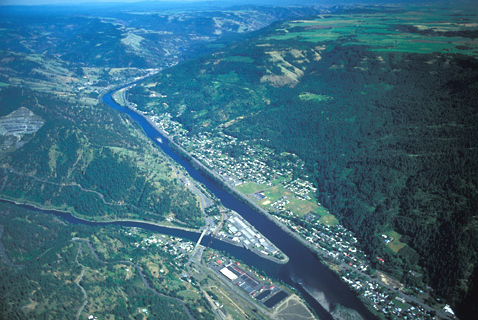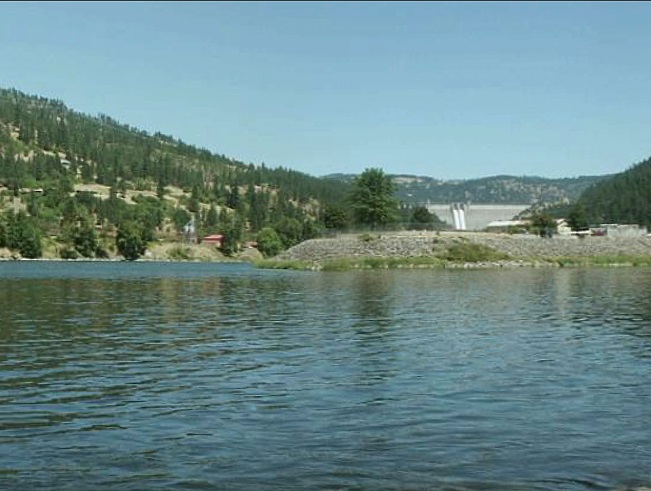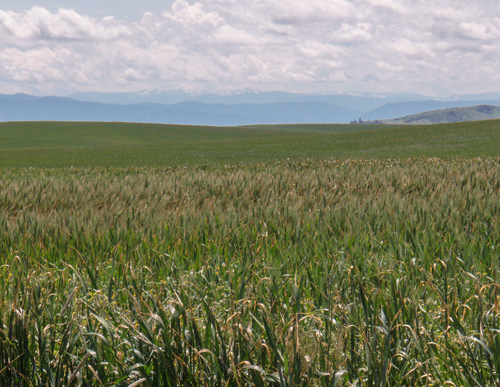Canoe Camp by Air
Clearwater Canoe Camp by Air
To see labels, point to the image
© 2001 Airphoto, Jim Wark. All rights reserved.
The Nez Perce word ahsahka means “forks of a river.” That was the name of an Indian village that once was situated across the river from the settlement which today is called Asahka (bottom center).
Still sick and exhausted from their recent crossing of the Bitterroot Mountains, Lewis, Clark, and their crew arrived on 26 September 1805, at what they called Canoe Camp, on the Clearwater River. In the photo, the camp was near the point of the triangle at lower right, between the highway and the south (right) bank of the river. The stream entering from the left is the North Fork of the Clearwater, which the captains named the Chopunnish River after what they understood as the Nez Perces‘ name for themselves. For the next twelve days, in oppressive heat, the Corps burned and hacked, with axes “Small & badly Calculated” for the task, five dugout canoes from large ponderosa pine logs.
They also established firm friendships with several generous and helpful Nez Perce Indian leaders who lived nearby: We-ark-koomt, or Apash Wyakaikt (Flint Necklace); Tun-nach’-e-moo-toolt (Broken Arm); Walamottinin (Twisted Hair); Neesh-ne-park-ke-ook (Cut Nose); and Te-toh ar sky, who, with one of his sons, would guide the expedition as far as the Great Falls of the Columbia, at today’s The Dalles, Oregon. Both captains, always listening closely to unfamiliar tongues, labored to write phonetic approximations of Indian names and other vocabulary.
On their return trip, the Corps camped about twenty miles upstream from here from 13 May 1806 to 10 June 1806. Lewis’s 17 May 1806 diary entry reflects the homesickness and frustration all the men endured. “I am pleased at finding the river rise so rapidly,” for it signified the steady progress of the spring thaw in the mountains, “that icy barrier which separates me from my friends and Country, from all which makes life esteemable.” He chided himself: “Patience, patience.”
Dwarshak Dam
Opposite the expedition’s canoe camp on the Clearwater River, and nearly 2 miles above its confluence with the main Clearwater, is Dworshak Dam, which was built in 1966–1973. The dam and reservoir are named in honor of U.S. Senator Henry Dworshak (1894-1962), the leading proponent of the controversial project in Congress.
Whereas most large dams are curved against the pressure of deep reservoirs, the 717-foot-high Dworshak Dam is the tallest straight-axis concrete dam in the Western Hemisphere. It creates a reservoir—650 feet deep at the dam—which extends 54 miles up the North Fork.
Dworshak Dam’s purposes were 1) to hold back and gradually release annual spring freshets on the 135-mile-long North Fork of the Clearwater, and 2) to generate hydroelectric power. However, simultaneous operation of all six of the power generators built into the dam would have required the construction of another dam some miles below the conflux of the two rivers. Therefore, with one generator producing only power for the dam itself, only three of its generators can be operated at one time.
Furthermore, the dam is too high to accommodate fish ladders, so two fish hatcheries are situated on the pointed upstream angle of the conflux, where three species of salmon are spawned—steelhead, chinook and coho salmon—and hauled up the North Fork canyon to finish their growth.
Camas Prairie, 1806
Camas Prairie
View east
© 22 June 2008 by Kristopher Townsend. Permission to use granted under the Creative Commons Attribution-Share Alike 4.0 International license.
Above: the Bitterroot Mountains can just be made out behind the farmer’s field.
Returning to Clearwater river on 7 May 1806, the Corps climbed from the canyon up onto Camas Prairie, “a butifull fertile picteresque Country.” With the appreciative eye of a Virginia farmer, Lewis regarded it almost longingly: “the Soil is dark rich loam, thickly Covered with grass and herbaceous plants which afford a delightful pasture for horses.” The soil he was admiring is not loam, however, for that term denotes a mixture of sand, clay, silt, and organic matter. Instead, it is old volcanic ash and basalt, which is loaded with the minerals that plants thrive on. Camas Prairie, like Weippe Prairie to the northeast, is indeed fertile. From the second half of the 19th century up to the present time it has produced fine crops of grain. By means of several aerial tramways located at strategic points along the canyon’s rim, the grain once was delivered to steamboats and freight trains along the river for shipment to market in Lewiston.



